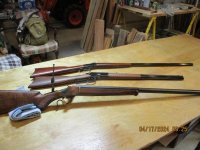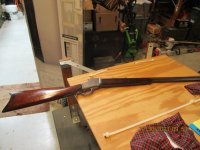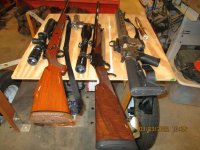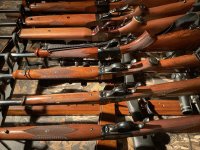Charlie Foxtrott
Member
- Joined
- Oct 27, 2009
- Messages
- 1,260
- Reaction score
- 2,112
A very good write up.
The one exception being that you neglected to mention the original reason for TG Bennet's reason for going out to Utah in the first place. Apparently, there was a disagreement concerning a loading tool patent infringement that they were attempting to work out.
With that said I have been a big fan of these rifles for a very long time.
This is a draft preview of a future article - as always, comments welcome!
John
The Winchester Model 1885 Single Shot rifle

An original 1885 low wall. (click for larger view)

An original 1885 high wall with the action open. (click for larger view)
Can you imagine a 23-year-old man, just a few years out of his teens, designing and patenting an epochal rifle and then selling it for manufacture to a major firearms company? And can you believe that over 130 years later, that rifle is still in demand and still being made? Sure, it's hard to believe, but that man was incredibly exceptional. His name was John Moses Browning, and it was his very first design, the forerunner of many more to come. It was a single-shot falling block underlever rifle – strong, smooth-acting, quick to operate and versatile enough that was eventually chambered in over 91 calibers!
Browning designed the gun in 1878, and in the age of notable single shot rifles such as made by Remington, Sharps, Stevens, Maynard and others, it was a standout. In those days, competitive rifle target shooting was very popular, and some of Browning's single shots, hand-made in his shop in Ogden, Utah, began to appear on the firing lines. They proved to be a hit with competitive shooters. The gun had some noteworthy features. The hammer retracted downwards so as to be out of the way as the action was opened, allowing quick and easy loading and unloading. The falling breech block was robust and locked up like a bank vault, enhancing accuracy and allowing heavily-loaded cartridges to be fired safely. The trigger was crisp. The receiver was made of premium steel, with two sizes of sidewalls available. The self-cocking hammer was of the traditional three-position type (down, half-cock, and full cock). Either open sights or tang-mounted vernier aperture types could be used.
The Browning shop, operated by John and his brothers, was hard-pressed to keep up with demand for this rifle, as they were only geared for laborious one-at-a-time manufacturing. Fortuitously, Thomas G. Bennett, then V.P. and general manager of Winchester Repeating Arms Company in New Haven, Connecticut, became aware of the Browning single shot. At that time, Winchester did not have a single shot rifle in its lineup, and needed one badly that could be more than viable for competition in that category. Accordingly, in 1883, Bennett traveled to Utah to meet with John Browning. While there, he negotiated the purchase of the single shot patent, and also acquired the prototype of what was to become the Winchester Model 1886 lever action rifle. John Browning's falling block design became a production item at Winchester in 1885, and became known as the Model 1885 single shot rifle. Browning and Winchester continued to enjoy a mutually beneficial relationship for a 19-year period, with a number of other notable and popular long arms coming to fruition.
There were two main types that evolved for the Model 1885. The "low wall" version showed a mostly-exposed hammer, and was designed for less powerful cartridges. The "high wall" style was more appropriate for higher powered rounds. Its frame covered most of the hammer when viewed from the side. It should be noted that some high walls were occasionally chambered for .22 rimfire and pistol-type centerfire cartridges. Both were Browning innovations, and both were designated and marketed by Winchester as the "Single Shot Rifle." Both low and high wall were available with two frame profiles: thick side and thin side. The thick side frame has flat sides that do not widen out to match the stock. The thick side is found more commonly on low wall rifles and it's somewhat rare on high walls. The thin side frame has milled sides that widen to match the stock.
The new Winchester took the competitive shooting market by storm. Major Ned Roberts, a noted "gun guy" of that era (and the originator of the .257 Roberts round), described the Model 1885 as "the most reliable, strongest, and altogether the best single shot rifle ever produced." Many today would argue that it still is. The Model 1885 has been replicated (notably by Uberti), and the Single Shot is still being manufactured for Winchester in Japan.
From 1885 to 1920, Winchester manufactured almost 140,000 single shots. The action proved to be so tough that Winchester used it even after production ceased to test fire new rifle cartridges loaded to very high pressures. It was a versatile platform, and was made in more calibers than any other Winchester rifle. Numerous single shots in .22 caliber were made and shipped to the U.S. Army for marksmanship training. These "Winder muskets" were distinguished by nearly full-length stocks. They were informally named for Col. C. B. Winder, who liked the idea of using rifles about the same size as service guns, but chambered for .22 rimfire. The Winder musket had a 26" barrel, a Lyman receiver sight and was chambered in either .22 Short or .22 Long Rifle
Over its years of production, several styles of the rifle were offered. These included Plain Sporting Rifle, Special Sporting Rifle, Special Single Shot (competition) Rifle, Shuetzen Rifle, Musket, Carbine, and (20 gauge) Shotgun. In actuality, Winchester could provide about anything a customer could desire. Barrels as short as 14" (trapper style) and as long as 38"could be ordered. The barrels could be round, octagonal, or half-round (most often seen on Schuetzens). Color casehardened frames were available until August, 1901. Other options were fancy wood, set triggers, special sights, takedown styles, and cartridges as small as .22 CB to as large as .577 Eley. Both rimmed and rimless cartridges could be accommodated, and were. Telescopes, nickel, silver and gold plating, checkered and carved stocks and custom engraving could all be provided by the factory. The versatility of this gun allowed virtually any combination of features, and the factory was very busy with special orders.
Winchester's modern line of 1885 rifles, made by Miroku in Japan and initiated in 2005, was dubbed the "Limited Series." These fire present-day smokeless rounds, including .17 Remington, .243 Winchester, and .30-06 Springfield. The newer guns are equipped with rubber recoil pads and straight butts as standard equipment. The "Traditional Hunter" group is reminiscent of 19th Century styles with crescent butt plates and folding tang peep sights. They are made in .38-55, .405 Winchester (Teddy Roosevelt's favorite African chambering), .45-70, and .45-90. The Low Wall can be chambered in .22 Hornet, .222 Rem., .223 Rem., .22-250 Rem., .243 Win., .204 Ruger and 6.5x55 Swede. A Low Wall Hunter is offered in .22 LR, .22 WMR, .17 HMR, as well as .17 WSM.
The rifle is operated as follows: Swing the lever down and fully forward to lower the breech block and the hammer. If a fired case or loaded round is present in the chamber, it will be backed out or ejected. Manually insert a cartridge into the chamber. It should be fully inserted to prevent interference with the breech block when it closes. The top front surface of the breech block is channeled to help load a cartridge that protrudes a bit from the chamber, but it's best to be sure to push the round all the way in. Then close the lever. This locks the action and leaves the hammer at full cock. The gun is then ready to fire. If shooting is not imminent, the correct position of the hammer should be at half cock; it only takes a moment to cock the hammer to make it ready to fire again. If several shots are anticipated, many users will hold a few cartridges between the fingers of the support hand for quick grasping and insertion by the firing hand.
The rifle requires little or no disassembly for cleaning or lubricating purposes, as the action virtually exposes itself when the lever is moved down and forward. For low wall versions in .22 rimfire, the firing pin channel in the breechblock may require cleaning after maybe 10,000 or so rounds are fired. In the top of the breechblock there is a firing pin retaining screw offset a bit to the left. With an appropriately fitted screw driver, it can be unscrewed and removed carefully, while intercepting the spring-loaded firing pin with a finger. Once the firing pin and its spring are removed, the channel can be cleaned with a pipe cleaner and solvent and lightly lubed. The firing pin and spring can then be replaced, pushed forward with an appropriate probe, and the retaining screw re-inserted and tightened.
Amazingly, John Browning's first invention is still with us today in modern versions. For the collector, originals will bring multiple thousands of dollars when found in any decent shape. Prices vary widely depending on the options present on the gun and condition. Modern Winchesters can be found and purchased for less than two thousand dollars each, while overseas reproductions are a bit more affordable. This rifle is a prized classic collectible for many, and fun to shoot.
(c) 2019 JLM
The one exception being that you neglected to mention the original reason for TG Bennet's reason for going out to Utah in the first place. Apparently, there was a disagreement concerning a loading tool patent infringement that they were attempting to work out.
With that said I have been a big fan of these rifles for a very long time.
Attachments
Last edited:








